7 Advantages of Using a Proper Dehumidifier in the Winter for Greenhouse
Winter's icy breath can turn a cannabis greenhouse from a haven of growth into a challenging landscape. While frosted windows and the pitter-patter of snow might seem like the primary adversaries, humidity is another subtle yet crucial factor. A drop in moisture levels isn't just about crisp winter air; it's about the environment your cannabis plants are trying to thrive in. This is where using a dehumidifier in the winter steps in. Dive into this guide to understand the profound impact of winter on greenhouse humidity and how the right dehumidifier can be your key to sustaining a vibrant harvest.
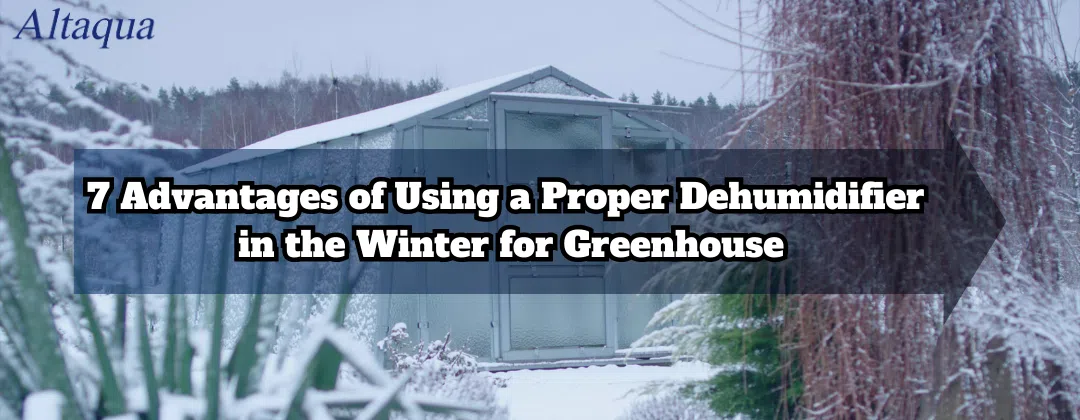
Understanding the Cannabis Greenhouse Environment
Regardless of its primary crop, every greenhouse is a controlled environment, designed to foster ideal growing conditions. For cannabis, an industry that's blooming globally, the stakes are higher, given the plant's sensitivity to environmental changes. Two crucial aspects define this environment: humidity and temperature.
Ideal Humidity Level
So, first things first, what's up with humidity? It's all about water in the air. Cannabis plants love it - but not too much or too little. Just right. Think of Goldilocks, but for plants. And this balance can be challenging, especially without a dehumidifier in the winter.
For cannabis cultivation, especially within greenhouses, managing humidity is crucial. The ideal humidity varies based on the growth stage of the cannabis:
|
Growth Stage |
Growth Stage |
Ideal RH |
|---|---|---|
|
Germination |
The seed begins to grow |
Around 70% |
|
Vegetative |
The seed begins to grow |
Between 40%-70% |
|
Flowering |
The plant starts producing buds |
Between 40%-50% |
|
Late Flowering |
In the last weeks before harvest to reduce mold risks |
Between 30%-40% |
What is Relative Humidity?
Ever heard folks talk about Relative Humidity or RH? Before diving into the specifics, let's understand a term often used in this context: Relative Humidity. It's just a way of saying how much water is in the air compared to how much it can hold. If the RH is 50%, it's holding half the water it could. When growing cannabis, you want the RH to be 40-70% when they're young and 40-50% when they flower.
Ideal Operating Temperatures
Just as with humidity, temperature plays a vital role in cannabis cultivation. Keep your greenhouse around 68°F to 77°F (20 - 25 °C) in the daytime. Don't let it get colder than 59°F (15 °C) when it's night. And when temperatures drop, using a dehumidifier in the winter helps keep the balance, ensuring the environment stays perfect.
Target Humidity and Temperature in winter
But winter? That's a whole other game. Cold air is like a sponge; it doesn’t hold much water. So, you might think of using a dehumidifier in the winter to suck out any extra wetness but be careful. You don't want things too dry. Target humidity is about 40-50% RH. And remember, keep things above 59°F (15 °C) at night. Even in winter, you've got to find that sweet spot for your cannabis.
The Significance of Humidity in Cannabis Cultivation
Growing cannabis isn't just about planting a seed and watching it shoot up. There's a rhythm, a balance, especially when winter swoops in. With its coldness and unpredictability, winter emphasizes the need for a dehumidifier in the winter in your cannabis greenhouse.
Benefits of Using a Dehumidifier in the Winter
When Jack Frost comes knocking, your cannabis plants can feel the chill. But it isn't just the cold that's a concern. The moisture, the dampness - that's the hidden challenge. When you use a dehumidifier in the winter, it's more than just managing moisture. It's about giving your cannabis the ideal space to flourish, free from the weight of dampness in the atmosphere.
How Humidity Influences Crops Growth
Humidity is like that silent player in a band; you might not always notice it, but boy, does it make a difference. If your cannabis could talk, they'd tell you. Too much moisture, and they feel drowned. Too little, and they're dried. The key? Striking the right balance, especially with the help of a dehumidifier in the winter.
Common Humidity Issues in the Winter
Winter, with its icy fingers, can play tricks on your greenhouse. Sometimes, it's visible, like the frost on your plants. Other times, the sneaky rise in humidity makes your cannabis struggle. Dampness can lead to mold, rot, and a host of problems. And this is where the magic of a dehumidifier in the winter becomes evident, helping ward off those unwanted moisture troubles.
- Mold and Mildew Growth: Excess humidity can be a breeding ground for mold and mildew. These fungi thrive in moist conditions and can seriously damage your cannabis plants.
- Pest Infestations: Bugs like spider mites and whiteflies love higher humidity. They can multiply faster and wreak havoc in a damp environment.
- Disease Proliferation: Bacterial and fungal diseases are easier to spread in elevated humidity conditions. This can lead to plant diseases that may affect yield and quality.
- Condensation: This can lead to water droplets forming on the plant, magnifying light, and burning the plants. It can also cause pooling of water, leading to root rot.
- Poor Plant Transpiration: In super humid conditions, plants might hold back on letting water out from their foliage. This reluctance can slow down their growth and mess with their nutrient absorption.
- Bud Rot: Especially in the flowering phase, high humidity can cause the dense buds of cannabis plants to rot from the inside out.
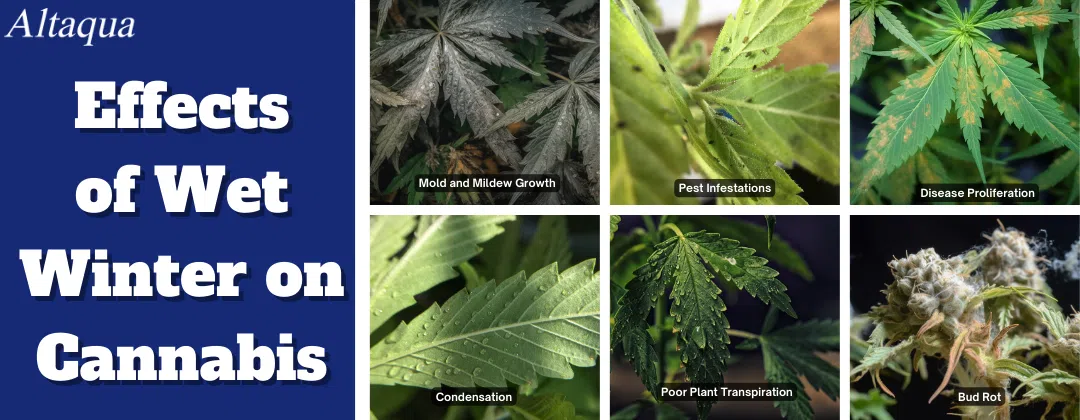
What is a Dehumidifier?
A dehumidifier acts like a vacuum for moisture, drawing out surplus dampness from the air and making our living or working spaces feel a whole lot cozier and healthier. These devices have had quite the glow-up since their initial introductions back in the 20th century. They don’t just scoop out moisture these days; modern units boast advanced features, loaded with sensors and fine-tuning options to nail the perfect ambiance.
How a Dehumidifier Works in the Winter
Imagine having a magic box in your greenhouse that invisibly battles the excessive moisture, a silent guardian for your plants. That's essentially your dehumidifier in the winter. Its primary job? Suck in air, remove the extra moisture, and then release the drier air. In winter, when the cold can make your greenhouse's humidity levels act like a roller coaster, this device ensures a smoother ride.
Which Dehumidifiers to Use in the Winter?
Now, not all dehumidifiers are made equal. Think of it like shoes; you wouldn’t wear flip-flops in the snow, right? So, when choosing a dehumidifier in the winter, you've got some options:
- Refrigeration-Based Dehumidifiers
These are the most common types. They work like your fridge. Air goes in, meets cold coils, loses its moisture (which collects into a tray), and then the drier air returns. Perfect for a cannabis greenhouse, especially during those winter months.
- Desiccant Dehumidifiers
Imagine silica gel packs but on steroids. These dehumidifiers use a desiccant material to soak the moisture directly from the air. They can be super efficient, especially when dealing with colder temperatures. So, for a cannabis greenhouse, having one of these dehumidifiers might be the ace up your sleeve.
- Thermo-Electric Dehumidifiers
These dehumidifiers leverage the Peltier process to condense and remove moisture without moving parts, making them quieter than other types. They're particularly suitable for smaller areas.
- Whole-house Dehumidifiers
And while you might picture a portable unit you can move from room to room, there are also beefier setups that hook right into a home's central heating and cooling systems, keeping the whole place on point, humidity-wise.
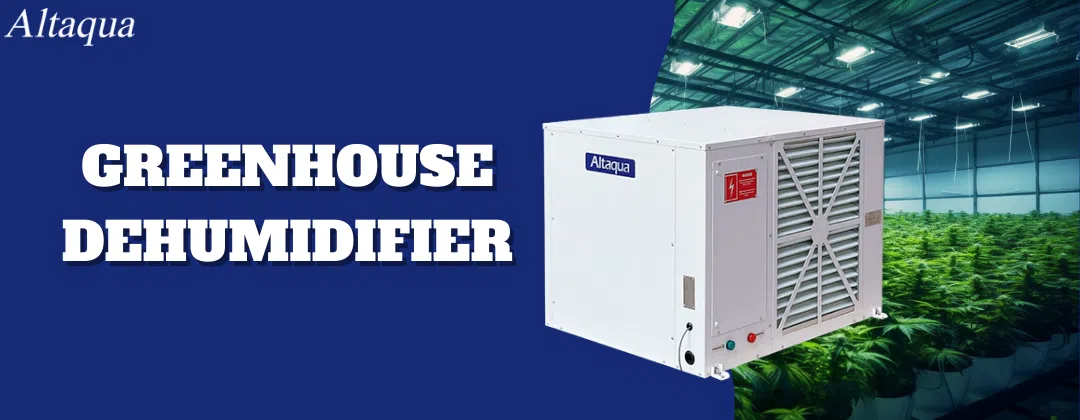
The Need for a Dehumidifier in the Winter
With its icy grip, winter tends to have an overlooked side effect beyond the visible frosted windows and chilly breezes. In a cannabis greenhouse, even as the outside world is enveloped in a white blanket of snow, the inside environment can become a battleground. Here's where a dehumidifier in the winter comes into play.
Improve Air Quality
Indoor air quality is paramount for plant growth. Excess moisture can lead to a buildup of contaminants and allergens, affecting plant and human health. Utilizing a dehumidifier in the winter ensures that the air remains fresh, crisp, and conducive to healthy cannabis cultivation.
Preventing Condensation
Condensation can be a grower's worst nightmare. The cold winter air combined with indoor heating can lead to water droplets forming on surfaces, including plant leaves. This moisture can become a breeding ground for mold and other pathogens. A dehumidifier in the winter can nip this issue in the bud, reducing moisture buildup and preventing the pitfalls of condensation.
Preventing Mold and Mildew Growth
Mold and mildew, the silent invaders, thrive in moist environments. In a cannabis greenhouse, these fungi can wreak havoc, affecting the quality and yield of the harvest. Controlling humidity levels with a dehumidifier in the winter ensures that these unwanted guests stay away from your precious plants.
Promoting Transpiration
Transpiration is how plants "breathe," releasing water vapor from their leaves. However, if the air is already saturated with moisture, plants struggle to release water, affecting their health and growth. With a dehumidifier, you assist plants in maintaining this vital process, ensuring they grow strong and yield bountifully.
Ensuring Consistent Bud Quality
The quality of cannabis buds is directly influenced by the environment in which they grow. Too much moisture? You risk spongy buds. Too dry? They become brittle. Using a dehumidifier in the winter helps strike the right balance, leading to consistent, high-quality buds.
Reducing Pest Risks
Pests love damp environments. From spider mites to aphids, many pests are attracted to moist conditions, posing a risk to cannabis plants. Maintaining ideal humidity levels with a dehumidifier in the winter creates an environment less inviting to these pesky intruders.
Helps Eliminate Dust Mites
Dust mites, though microscopic, can pose significant problems in a greenhouse setting. These critters thrive in moist conditions. Using a dehumidifier reduces their numbers, ensuring a cleaner, healthier environment for your cannabis.
Tips for Using a Dehumidifier in the Winter in a Greenhouse
Having established the importance of a dehumidifier in the winter for your cannabis greenhouse, it's time to delve into some best practices. For a longer-lasting dehumidifier that operates at its best, good care and usage are key.
Choosing the Right Size and Capacity
One size doesn’t fit all, especially in the world of dehumidifiers. For a cannabis greenhouse, you'll want to match the unit's capacity to the size and humidity level of your space. A unit too small will run continuously without achieving desired humidity levels, while a unit too large might cause rapid fluctuations in humidity.
The art of choosing the ideal dehumidifier in the winter for your cannabis greenhouse relies heavily on understanding the size and capacity needs. Here's a deeper dive:
- Evaluate Your Space
The size of your greenhouse directly impacts the type of dehumidifier you need. Determine the size of your greenhouse. For example, a small greenhouse of 100 square feet might require a unit with a capacity of 30 pints per day, while a larger 1000 square feet facility might demand a unit capable of handling 70 pints or more per day.
- Consider Your Location Moisture Level
A greenhouse in humid regions or during peak rainy seasons might accumulate moisture faster than in dry areas. This influences the capacity of the dehumidifier you select.
- Understand Unit Capacities
Dehumidifiers are often rated by the number of pints of moisture they can remove in 24 hours. If your greenhouse accumulates about 5 gallons (or 40 pints) of water daily, you'll need a dehumidifier that can handle at least that, if not slightly more, for buffer.
Example:
Let's consider John's cannabis greenhouse, located in Florida – a region known for its high humidity. His greenhouse is about 500 square feet. After researching, John discovered that, given Florida's humidity levels, his greenhouse accumulates about 50 pints of water daily. He then opted for a dehumidifier rated at 70 pints per day, giving a margin for extremely humid days and ensuring consistent moisture control.
- Consult Manufacturer Recommendations
Leading brands like Desert Aire, AgronomicIQ, Anden, and Altaqua provide detailed guidelines on which products suit specific spaces and humidity levels. When in doubt, contacting the manufacturer or a local expert can clarify.
In conclusion, picking the proper dehumidifier for your cannabis greenhouse is not just about the current moisture but planning for peak times. Ensuring you have a unit that can comfortably handle your space's demands will save energy costs and maintain an ideal growing environment.
Ideal Placement
The location of your dehumidifier in the winter matters. For maximum efficiency, please place it in the center of the greenhouse or where humidity is highest. Ensure there's ample space around the unit for proper air circulation. Avoid placing it near doors or windows to prevent cold drafts, as it might reduce efficiency.
Determine How Long To Run Your Dehumidifier in the Winter
Continuous operation is only sometimes necessary. Depending on the external weather conditions and the internal humidity level, running the dehumidifier for specific intervals suffices. Using a hygrometer to see humidity levels guides you on when to run your dehumidifier.
How To Maintain Your Dehumidifier In The Winter
A well-maintained dehumidifier is a happy dehumidifier. Regular maintenance not only ensures it functions optimally but also extends its lifespan.
- Filters: Clean or replace the filters regularly.Clogged filters make the unit work harder and can lead to inefficiency and wear.
- Coils and Grilles: Ensure coils are free of dust and debris. This helps maintain optimal performance and reduces strain on the unit.
- Collection Bucket: Regularly empty the collection bucket, ensuring it's clean and free of mold or mildew. Some units have an automatic shut-off feature when the bucket is complete - a handy feature to prevent overflow.
Get the Proper Dehumidifier from Altaqua
Altaqua has become synonymous with quality when it comes to dehumidifying solutions. Especially for a demanding environment like a cannabis greenhouse, flower rooms, choosing a trusted brand can make all the difference.
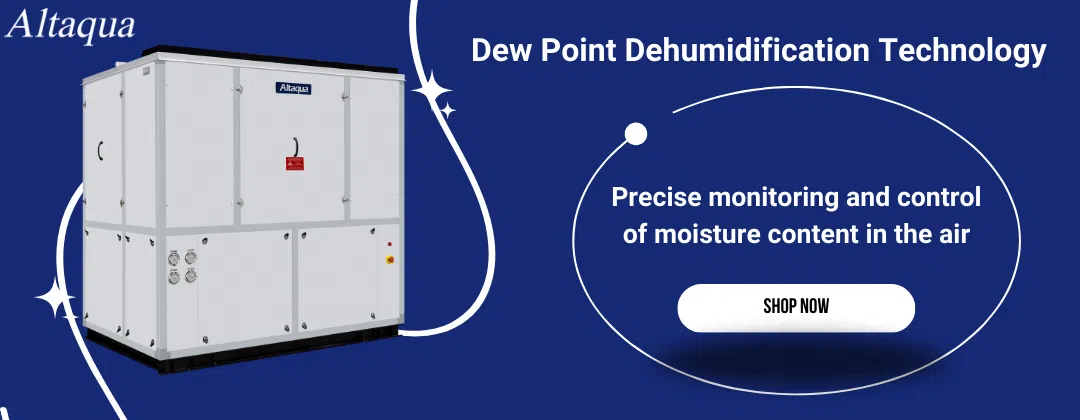
Here's why considering Altaqua for your dehumidifier in the winter might be a great idea:
- High-Efficiency Units: Altaqua's dehumidifiers are known for their efficiency. Even in the harshest winter months, they ensure optimal humidity levels, providing the right atmosphere for cannabis growth.
- Customized Solutions: Every greenhouse is unique. Altaqua offers tailored solutions based on the specific needs of your facility. From size to capacity, they have you covered.
- Reliable Performance: Winter can be unpredictable. But with an Altaqua dehumidifier, you can expect consistent results regardless of outside weather. No more waking up to unexpected humidity spikes!
- User-Friendly Features: Altaqua dehumidifiers have a range of features that make them easy to use. Think smart controls, remote monitoring, and automated settings that adjust based on real-time humidity levels.
- Durability: Built to last, Altaqua dehumidifiers can withstand the rigors of daily use in a busy cannabis greenhouse. Investing in one means peace of mind for many winters to come.
- Expert Support: Have a question or need some advice? Altaqua's team of experts is always ready to assist. From installation guidance to maintenance tips, they're just a call away.
The Dual Role of Humidifiers and Dehumidifiers
When it comes to managing the climate inside a cannabis greenhouse, it's not just about removing moisture. Sometimes, adding moisture is equally important. Here's a breakdown of the dual roles played by humidifiers and dehumidifiers:
- Optimal Growth Environment: With the right balance of humidity, cannabis plants can grow stronger and yield more. A dehumidifier in the winter prevents excess moisture, while a humidifier ensures the air isn't too dry.
- Disease Prevention: Fungi and certain pests thrive in particular humidity levels. Controlling humidity reduces the risk of diseases and pests, keeping your crops healthy.
- Energy Savings: Running a dehumidifier or humidifier when necessary can save heating and cooling costs. By maintaining the right humidity, the greenhouse temperature is easier to control.
- Enhanced Comfort: The right humidity levels can make the environment more comfortable for those working in the greenhouse, ensuring better productivity and fewer health concerns.
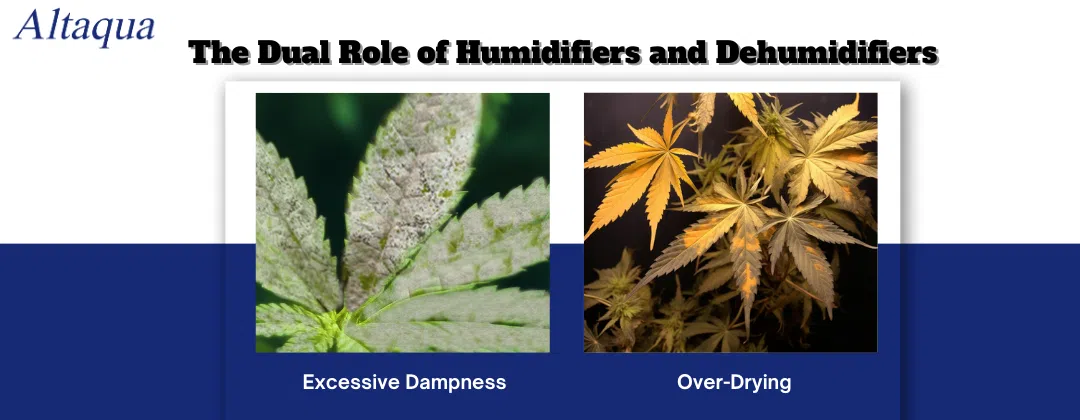
The Differences Between Humidifiers And Dehumidifiers
- Function: While it's in the name, it's worth emphasizing: dehumidifiers remove moisture from the air, making environments less humid. Humidifiers do the opposite, adding moisture to make places more humid.
- Usage Scenarios: You'd use a dehumidifier in the winter when the air inside the greenhouse becomes too moist due to condensation or inadequate ventilation. Conversely, humidifiers come into play when the indoor air is too dry, which can happen with intense heating.
- Size & Placement: Dehumidifiers are generally larger and need to be placed in areas with the most moisture, like near plants or vents. Humidifiers, while also sizable, can often be placed in various locations, as they aim to distribute moisture.
- Maintenance: Both devices need regular care. Dehumidifiers require periodic cleaning of coils and buckets, while humidifiers need water tank refills and, in some cases, filter changes.
While they serve different purposes, humidifiers and dehumidifiers are crucial in maintaining the perfect environment inside a cannabis greenhouse, especially during the challenging winter months. Knowing when and how to use them can significantly influence the quality and yield of your cannabis crops.
Types Of Humidifiers And How They Work
|
Category |
Type |
How They Work |
Usage |
|---|---|---|---|
|
Warm Mist Humidifiers |
Steam Vaporizers |
Electrically heated to produce steam, which cools slightly before leaving the machine. |
Suitable for reducing germs and bacteria. Consumes more electricity. Can get quite hot, so safety is a concern. |
|
Cool Mist Humidifiers |
Evaporative Humidifiers |
A wick filter absorbs water. A fan then blows air through the moistened filter, causing the water to evaporate, which adds moisture to the air. |
Self-regulating: as the air becomes more humid, the evaporation process slows down. |
|
Cool Mist Humidifiers |
Ultrasonic Humidifiers |
They produce a fine water mist released into the air using ultrasonic vibrations. |
Quieter than evaporative models. Available in various sizes, suitable for both large rooms and small spaces. |
|
Cool Mist Humidifiers |
Impeller Humidifiers |
These use a rotating disk to fling water at a diffuser, breaking the water into fine droplets released into the air |
Produces cool mist and is generally quieter than evaporative humidifiers. |
|
Hybrid Humidifiers |
Combination of Ultrasonic & Evaporative |
Combines features of both ultrasonic and evaporative humidifiers. |
Offers advantages of both types and can provide a more stable humidity level. |
Sizing And Installing A Humidifier
Choosing the right humidifier is a complex pick-and-grab.. It's about understanding the unique needs of your cannabis greenhouse, especially during winter.
- Gauge Humidity Needs: Use tools like hygrometers to measure your greenhouse's current moisture levels.
- Right Size is Key: Match the humidifier's output (usually gallons per day) to your space. Too small might not add enough moisture, while too large might over-humidify.
- Placement Matters: Central positioning helps distribute moisture evenly. Avoid blockages and consider elevation for better distribution.
- Maintenance Access: Install the unit where it's easy to reach for cleaning and upkeep.
- Water Source Connection: Larger units might need direct water linkage. Ensure a nearby connection point and use low-mineral water to avoid 'white dust'.
- Prioritize Safety: With water and electricity involved, always adhere to safety protocols, like using grounded outlets.
In summary, the right humidifier in the winter for a cannabis greenhouse is about balance. Proper setup ensures you maintain that balance effectively.
Conclusion
Achieving the Best Crops Yield with Balanced Humidity
The journey of mastering a cannabis greenhouse's environment is intricate, but the rewards are immense. Proper humidity management, particularly with the aid of a dehumidifier in the winter, is pivotal to this journey. Not only does it ensure the well-being of the crops, but it also significantly affects the yield and quality of the harvest.

Mastering the greenhouse environment means deeply understanding humidity and adeptly using humid and dehumidifiers. But remember, even the best tools need the touch of an experienced hand to shine truly. By diligently implementing the insights shared in this guide, growers can navigate the challenges of winter and pave the way for a flourishing cannabis harvest.
In a world where precision matters, using a dehumidifier in the winter is not just about equipment - it's a commitment to excellence. Here's to bountiful harvests and the balanced humidity that makes them possible!
FAQ:
1. Do I need to run a dehumidifier in the winter?
Yes, it's necessary to use a dehumidifier in the winter, especially if your indoor humidity levels are high. High humidity can lead to many problems, such as mold and mildew.
2.What should I set my dehumidifier to in the winter?
In winter, set your dehumidifier between 30-50%. This range helps prevent condensation and mold growth. Monitor the humidity level regularly to adjust the setting as needed.
3.Do dehumidifiers work differently in the winter?
Yes, dehumidifiers operate differently in winter due to colder air holding less moisture. For optimal cannabis growth in greenhouses, it's crucial to use models designed for cold conditions.
4.Should you use a humidifier or dehumidifier in the winter?
Whether to use a humidifier or dehumidifier in the winter depends on your indoor humidity levels. If your indoor air is too dry, a humidifier can help. If it's too humid, a dehumidifier would be more beneficial.
5.Why don’t drop relative humidity too low?
Dropping relative humidity too low can stress cannabis plants, hinder growth, and decrease yield, making it vital to maintain balanced humidity levels.
Share with your friends:
Popular Blogs on Altaqua:
Get HVAC Brochure?
Get HVAC Brochure?



